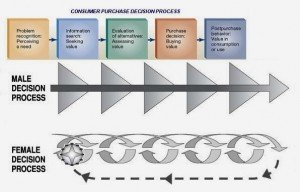Abstract
Women are great influencers when it comes to buying decision of the family. No doubt that when it comes to individual buying, women are the sole decision makers in the decision. Most often we think why women take longer duration in buying as compared to men or why they buy things that according to us are not required at that time. On a deeper analysis, we see that how science has affected the buying behaviour of women. This article explores the difference between buying behaviour of men and women, and certain processes involved in buying behaviour of women.
Understanding Women through Consumer Behaviour
Women are most powerful consumers in the world as they control almost 80 percent of the household spending. And no longer can the women’s spending powers and influence be neglected. The role of women in the society and their effects has changed. Most of the marketers know that ‘women are different’, but we actually need a deep rooted understanding of how and why they are different. Not all female are women, some are girls; not all women are moms; not all moms are women; they may or may not be ‘forever young’. What is important to analyze are the multiple roles that a female plays in her everyday life. A marketer cannot ignore her role as a mom and talk to her as a girl or women, and similarly a girl cannot be approached like a woman. Purchases are emotionally significant and communication is important throughout the buying decision.
On the Inside
Women think differently from men. Firstly why? The answer is because there are biological, neurological, and behavioural variations between the brains of men and women. These differences in turn make an impact on their buying behaviour. For example, there are more brain cells in men than in women but there are more fibre connections between brain cells in women than in men. Hence a brain of woman would tap all her senses and connect and share information at more levels than man. In this way, in marketing perspective, they look at a bigger picture and are either deeply connected to a brand or stay disconnected at all levels. At the same time, they also require more time to reach a buying decision than men. Men have larger brains as compared to women who have relatively smaller sized brains. Hence, while thinking, men have only one side of the brain (left hemisphere) active while women left and right hemispheres active. Thereby, men tend to have a more linear thinking whereas women have a holistic thinking and they are better at integrating things to arrive at a decision. Women are more in touch with their feelings because their emotions are distributed in the left and right hemisphere of the brain while men have their emotions concentrated in right hemisphere. Hence women have the tendency to stay better connected with their family, friends, and ‘brands’. Previous studies by neuroscientists have revealed that women are better at multi-tasking than men and that is why they take multi-minded decisions.
Implications on Buying Behaviour
Once women identify the need of a value, their first step towards buying is information search. They want a product that meets their demands and is easy and reliable. While men will load themselves with sufficient information of a product or service through internet, advertising, reviews; women would try to get benefit from others’ experience by asking the people around them. They prefer doing a front end research. Women would want detailed information from the staff and other people and attributes like opinion of her mates, the reputation of a company, environment of the store, price of a product/service would matter more.
Women usually start with a generalized sense of their need and then continue to evaluate alternatives. When a woman is buying a dress, she has multiple criteria like would this dress suit for a family gathering, and at the same time will it suit well in a more formal occasion; and what about washing. There are multiple criteria and when a dress does not meet all the criteria it is likely to be rejected. It is important to note that all the criteria usually have equal weight age. Men on the other hand have weights for criteria and will readily compromise on few. A woman will also reconsider her need at this stage in case she comes across an alternate that will still suit her needs than the former; it takes her back to the previous step of information search. Men tend to eliminate options and women tend to add options and for every new option, information search on that offering is revisited.
Male vs Female Buying Behaviour: Adapted from Marketing Management by Philip Kotler 13th Ed
There is a lot of comparison of the offering before the final purchase. Once a woman is sure that she has gathered enough information and evaluated all possible alternatives, she would arrive at a decision. But this buying behaviour of a woman does not end with purchase. Word of mouth for the value plays a significant part in post purchase behaviour. She would share her experience with the offering with her initial advisors, friends and other people in her circle. Another important aspect is loyalty. A brand or a product/service that has served her well will result in repurchase decision even though there may be an alternate that is less priced or exceeds in features to some extent. Though women are price sensitive but loyalty overtakes this sensitivity. For example, a salesperson of garment shop has served a woman for a couple of times. Even if a new store emerges in the vicinity of her home or offers at lower price, she will continue to repurchase from the former who has served her well and has a deeper connect.
Conclusion
It is important for marketers to note that the selling process of women take longer than men primarily due to backward spiral during purchase decisions, but the post purchase behaviour of women on a brand/product/service can have huge implication. Hence it is important for a marketer to provide as much information to a woman buyer as he can because communication plays an integral part in buying decisions. Men rely on their personal assessment while women rely more on personal trust when it comes to buying and are open for inputs at various stages. Women set their decisions and priorities not only according to their needs but also according to the people in her personal circle. Hence, it becomes important to position a product in a way that how they will benefit her and other in her life. But at the same time it is important to remember phrases like ‘not all women are moms, and not all female are women’.


































